Digital Poster
Magnetic Resonance Spectroscopy
ISMRM & ISMRT Annual Meeting & Exhibition • 03-08 June 2023 • Toronto, ON, Canada

| Computer # | |||
|---|---|---|---|
3934.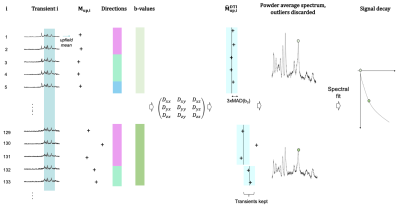 |
1 |
Rejecting or retaining motion corrupted transients in
diffusion-weighted MRS: high b-values and multiple directions
Clémence Ligneul1,
Jesper Andersson1,
Saad Jbabdi1,
Jason Lerch1,2,3,
and William T Clarke1
1Wellcome Centre for Integrative Neuroimaging, FMRIB, Nuffield Department of Clinical Neurosciences, University of Oxford, Oxford, United Kingdom, 2Mouse Imaging Centre, The Hospital for Sick Children, Toronto, ON, Canada, 3Department of Medical Biophysics, University of Toronto, Toronto, ON, Canada Keywords: Data Processing, Spectroscopy, Diffusion-weighted spectroscopy Robust processing is crucial for a reliable microstructural interpretation of advanced diffusion-weighted magnetic resonance spectroscopy (DW-MRS) methods. The spectral signal intensity depends on the direction when using strong diffusion-gradients and multiple directions, even more if the voxel content is very anisotropic (e.g. contains a white matter tract). In this study we propose a model-based way of identifying motion corrupted averages that accounts for the voxel anisotropy. |
|
3935.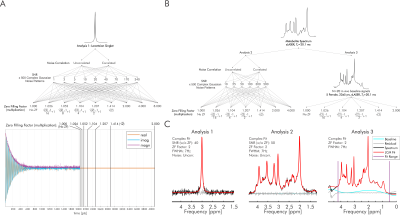 |
2 |
Zero filling does not inherently improve precision of real
relative to complex-domain fitting in 1H-MR spectra with
physiological baselines
Leonardo Campos1,
Kelley M. Swanberg1,
and Christoph Juchem1,2
1Biomedical Engineering, Columbia University, New York, NY, United States, 2Radiology, Columbia University, New York, NY, United States Keywords: Data Processing, Spectroscopy There remains controversy surrounding the use of zero filling during spectral quantification of in vivo proton magnetic resonance spectra (1H-MRS) using linear combination model (LCM) fitting. We examine the potential mixing of real and imaginary information theorized with zero filling, and whether this is demonstrated by a comparable change in accuracy and precision provided by complex fitting. We show that application of zero filling does improve fitting precision when a baseline is not present; with an imperfectly modeled unknown in vivo baseline, however, zero filling does not necessarily reduce error in real relative to complex fits. |
|
3936.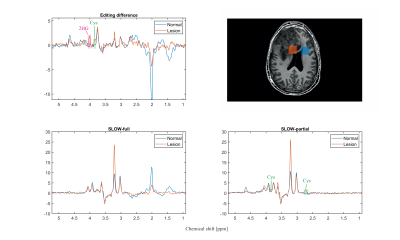 |
3 |
Simultaneous in vivo Detection of Cystathionine and 2HG at 7T
and Simulation of MEGA and SLOW-editing performance
Guodong Weng1,2,
Piotr Radojewski1,2,
and Johannes Slotboom1,2
1Support Center for Advanced Neuroimaging (SCAN), University of Bern, Bern, Switzerland, 2Translational Imaging Center, sitem-insel, Bern, Switzerland Keywords: Pulse Sequence Design, Spectroscopy, Spectral editing 2-Hydroxyglutarate (2HG) is a biomarker for IDH-mutant glioma, and previous studies have shown that cystathionine (Cys) can be a potential biomarker for 1q/19q co-deletion of glioma. Previous studies used SVS based MEGA-editing MRS to detect 2HG and co-edited Cys, but editing efficiency of Cys is not optimal due to the narrow bandwidth of the applied MEGA editing-pulses. This work shows that SLOW-editing is able to detect both 2HG and Cys in an optimal way with whole-brain coverage. |
|
3937.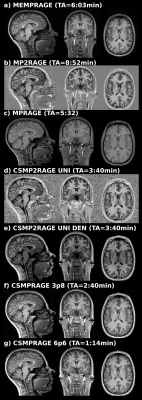 |
4 |
Compressed Sensing MPRAGE accelerates automated voxel placement
for 1-H MRS of the human brain
Stefano Tambalo1,
Sebastian Hübner1,
Francesca Saviola1,
Tobias Kober2,3,4,
and Jorge Jovicich1
1University of Trento, Trento, Italy, 2Advanced Clinical Imaging Technology, Siemens Healthineers International AG, Lausanne, Switzerland, 3Department of Radiology, Lausanne University Hospital and University of Lausanne, Lausanne, Switzerland, 4LTS5, École Polytechnique Fédérale de Lausanne (EPFL), Lausanne, Switzerland Keywords: Data Processing, Spectroscopy The automated voxel placement (AVP) framework has been proposed to optimize accuracy and reproducibility in single-voxel brain proton spectroscopy. AVP is based on the affine transformation of brain coordinates from standard to subject-specific space defined on a 3D T1-weighted structural scan. Here we evaluate the robustness of the AVP approach by evaluating the displacement of voxel center coordinates across 3D T1w MPRAGE sequence variants, including compressed sensing (CS) accelerated protocols. We show that AVP gave small but significantly higher voxel displacements for MP2RAGE and CS-MP2RAGE. There were no significant differences between multi-echo MPRAGE (6 min) and CS-MPRAGE (1 min). |
|
3938.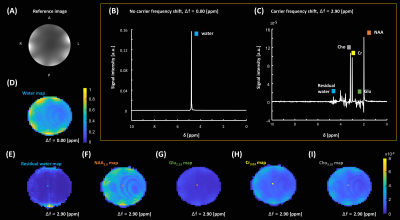 |
5 |
Development of a 2D MRSI sequence with Chemical-Shift Selective
Adiabatic Pulses (2𝜋-CSAP) using Pulseq at 7T
Kyung Min Nam1,2,3,
Guodong Weng2,3,
Nam G Lee4,
Edwin Versteeg1,
Yeong-Jae Jeon5,6,
Arjan Hendriks1,
Jannie Wijnen1,
Alex Bhogal1,
Dennis Klomp1,
Maxim Zaitsev7,
and Johannes Slotboom2,3
1Department of High Field MR, Centre for Image Sciences, University of Medical Centre Utrecht, Utrecht, Netherlands, 2Institute for Diagnostic and Interventional Neuroradiology, Support Center for Advanced Neuroimaging (SCAN), University of Bern, Bern, Switzerland, 3Translational Imaging Center, sitem-insel AG, Bern, Switzerland, 4Department of Biomedical Engineering, University of Southern California, Los Angeles, CA, United States, 5Lee Gil Ya Cancer & Diabetes Institute, Gachon University, Incheon, Korea, Republic of, 6Department of Health Sciences and Technology, GAIHST, Gachon University, Incheon, Korea, Republic of, 7Department of Radiology, Division of Medical Physics, University Medical Center Freiburg, Freiburg, Germany Keywords: Data Acquisition, Spectroscopy An MRSI sequence using a pair of chemically selective adiabatic 2𝜋 refocus pulses, referred to as 2𝜋-CSAP, was implemented using the open-source Pulseq framework. This sequence enables full coverage of the frequency spectrum of interest through a shift in carrier frequency, which has been a limitation in rapid MRSI sequences. In addition, this shifted frequency spectrum also minimizes signal contaminations from residual water signal after water suppression or unsuppressed water signal and strong lipid signals, possibly eliminating the need for additional water suppression pre-pulses. This base sequence can potentially be combined with accelerated acquisition techniques for better scan efficiency. |
|
3939.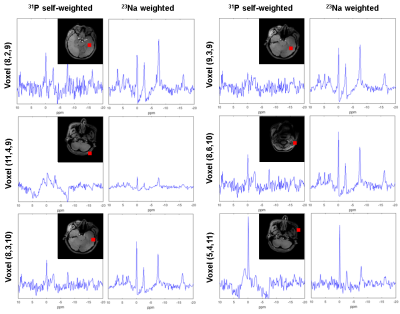 |
6 |
31P MRSI coil combination using 23Na sensitivity information
acquired with the same loop array at 7T: preliminary
verification
Jiying Dai1,2,
Mark Gosselink1,
Alexander J. E. Raaijmakers1,3,
and Dennis W. J. Klomp1
1UMC Utrecht, Utrecht, Netherlands, 2Tesla Dynamic Coils B.V., Zaltbommel, Netherlands, 3Eindhoven University of Technology, Eindhoven, Netherlands Keywords: Image Reconstruction, Spectroscopy We utilized a quintuple-tuned RF head coil array by using the high-SNR 23Na signals from the brain to optimize the weighting for combining signals from the same coil array elements for the low-concentrated 31P metabolites. 23Na-weighted Roemer combination of 31P MRSI signals is verified on EM simulations and MR experiments. Comparing to 31P self-weighted combination, 23Na-weighted combination shows higher SNR and better-combined spectra in regions with low intrinsic SNR. It also shows potential of mitigating the signal contaminations when using 31P-self-weights for 31P data acquired with large voxels. |
|
3940.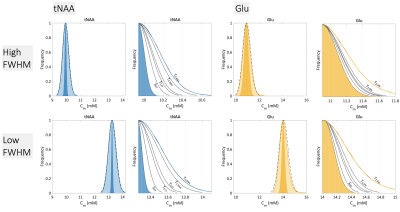 |
7 |
A Case Study Analysis on Monte Carlo-Simulated Uncertainty
Propagation in Absolute Quantification for in vivo 1H-MRS of the
Human Brain
Ronald Instrella1 and
Christoph Juchem1,2
1Biomedical Engineering, Columbia University, New York, NY, United States, 2Radiology, Columbia University, New York, NY, United States Keywords: Data Analysis, Spectroscopy, Brain, 1H-MRS, Quantification The effect of uncertainty propagation for absolute quantification performed on individual single-voxel in vivo 1H-MRS experiments has yet to be examined. In this case study, we conduct an uncertainty analysis using Monte Carlo simulations on two previously published studies with reported absolute concentrations of metabolites and macromolecules, each employing different field strengths, relative linewidths and internal references (e.g. total creatine, tissue-specific water). The uncertainty from 8 in vivo spectra is simulated and compared to CRLBs from Linear Combination Modeling. A multifold uncertainty increase is observed in both metabolites and macromolecules across datasets, demonstrating that the CRLB systematically overestimates quantification precision. |
|
3941.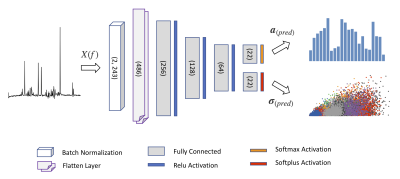 |
8 |
Predicting Uncertainty of Metabolite Quantification in Magnetic
Resonance Spectroscopy with Applications for Adaptive Ensembling
Julian P. Merkofer1,
Sina Amirrajab1,
Johan S. van den Brink2,
Mitko Veta1,
Jacobus F. A. Jansen1,3,
Marcel Breeuwer1,2,
and Ruud J. G. van Sloun1,4
1Eindhoven University of Technology, Eindhoven, Netherlands, 2Philips Healthcare, Best, Netherlands, 3Maastricht University Medical Center, Maastricht, Netherlands, 4Philips Research, Eindhoven, Netherlands Keywords: Machine Learning/Artificial Intelligence, Spectroscopy, Deep Learning, Uncertainty Prediction, Adaptive Ensemble Current deep learning methods for metabolite quantification in magnetic resonance spectroscopy do not offer reliable measures for uncertainty. Having a widely applicable measure can aid with the identification of fitting errors and enable uncertainty-based adaptive ensembling of model-based quantification and neural network predictions. In this abstract, we propose a training strategy based on a log-likelihood cost that allows joint optimization of concentration and uncertainty estimation for each individual metabolite. We show that the predicted uncertainties correlate well with the actual estimation errors and that uncertainty-based adaptive ensembling outperforms the individual estimators as well as standard ensembling. |
|
3942. |
9 |
2D spectral-temporal fitting of synthetic fMRS data improves the
precision of fitted glutamate temporal dynamics parameters
three-fold
Yiling Liu1,2,
Zhiyong Zhang1,
and Assaf Tal2
1School of Biomedical Engineering, Shanghai Jiao Tong University, Shanghai, China, 2Department of Chemical and Biological Physics, Weizmann Institute of Science, Rehovot, Israel Keywords: Data Analysis, Spectroscopy It has been suggested that fitting dynamic MRS data in tandem (2D fitting) should be more precise than conventional 1D fitting, without impairing its accuracy. Functional MRS (fMRS) is a dynamic method used for detecting endogenous metabolic changes in the brain. In this work, we implemented a 2D spectral-temporal fitting framework for the synthetic fMRS data. Preliminary experiments confirm that 2D fitting improves precision approximately three-fold compared to the conventional 1D fitting in terms of fMRS data. |
|
3943.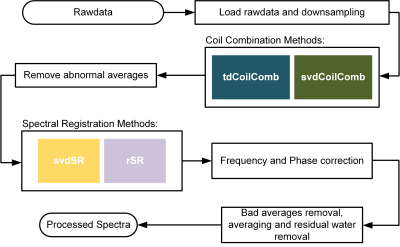 |
10 |
Optimization and comparison of coil combination and spectral
registration strategies for in-vivo DW-MRS
Ke Zhou1,
Ziyan Wang1,
Dingyi Lin1,
Yi-Cheng Hsu2,
and Min Wang1
1College of Biomedical Engineering & Instrument Science, Zhejiang University, Hangzhou, China, 2Siemens Healthcare Ltd, Shanghai, China Keywords: Data Processing, Spectroscopy, Spectra Registration Diffusion-weighted MRS (DW-MRS) suffers from low signal intensity and large phase errors when applying strong diffusion weighting. Coil combination and spectral registration are vital as spectra with high b-values are usually poorly reconstructed. This work aims at the optimization of post-processing pipeline with singular value decomposition (SVD)-based spectral registration and the comparison of different regimes of coil combination and spectral registration for in-vivo DW-MRS post-processing. The SNR of post-processed spectra and the metabolite diffusivities are assessed. The statistical outcomes suggest that the SVD-based spectral registration could improve the SNR of DW-MRS signal at high b-values and therefore alleviate diffusivity overestimations. |
|
3944. |
11 |
Comparison of FAST(EST)MAP and BOLERO shimming for single voxel
spectroscopy at 7T
Jullie W Pan1,
Melissa Terpstra1,
Junghwan Kim1,
and Hoby P Hetherington2
1Radiology, University of Missouri Columbia, columbia, MO, United States, 2Resonance Research Inc., Billerica, MA, United States Keywords: Data Acquisition, Spectroscopy, shimming Because of the small volumes (2 to 15cc) used in single voxel spectroscopy (SVS), field inhomogeneities over such voxels are thought to be well managed by low order shim methods, e.g., FAST(EST)MAP using 1st-2nd spherical harmonic shim terms. In this report performed at 7T (Siemens Terra) we evaluate SVS from a key region of interest (prefrontal cortex PFC) with FAST(EST)MAP in comparison with Bolero shimming, a method that specifically manages high order shim terms. High accuracy field maps and LCModel analysis of STEAM spectroscopy are evaluated. |
|
3945. |
12 |
Improved reproducibility of GABA measurement in short-TE 1H MRS
by linewidth-matched basis sets
Ying Xiao1,2,
Bernard Lanz1,
Songi Lim1,2,
and Lijing Xin1
1Animal imaging and technology, CIBM, EPFL, Lausanne, Switzerland, 2Laboratory for Functional and Metabolic Imaging (LIFMET), EPFL, Lausanne, Switzerland Keywords: Data Processing, Spectroscopy, LCModel This study investigated the spectral linewidth effect on GABA quantification, as well as its correction approach in LCModel with both simulated and in vivo acquired 1H MR spectra. Using the same basis set to fit spectra with different linewidths results in elevated variations between measurements. An effective method to reduce the variability caused by the linewidth difference effect and more accurately quantify GABA is to use spectral-linewidth-matched basis sets. This study shows the validity of this approach for most of the Voigt-type spectra. |
|
3946. |
13 |
Correlations of 31P-containing metabolites in human brain at 3
and 7 Tesla
Sungtak Hong1 and
Jun Shen1
1National Institute of Mental Health, National Institutes of Health, Bethesda, MD, United States Keywords: Data Analysis, Spectroscopy Numerical Monte Carlo analysis was performed to quantify metabolite-metabolite correlations of spectral origin in 31P MRS spectra acquired from human brain at both 3 and 7 Tesla without any confounding biological correlations. Significant correlations were found for many 31P-containing metabolite pairs. In particular, the 3 and 7 Tesla NAD+-NADH correlations are significantly different because of the field strength difference. These results demonstrate that it is necessary to incorporate metabolite-metabolite correlations originating from spectral overlap into statistical models that correlate MRS measurements with clinical parameters when overlapping 31P signals are of clinical interest. |
|
3947.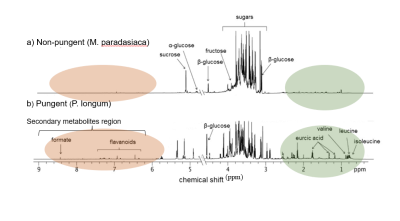 |
14 |
Can NMR phytometabolomics play a role in prevention and
management of obesity?
Ankita Singh1,
Aruna Singh1,
Dushyant Kumar1,
and Rama Jayasundar2
1NMR, All India Institute of Medical Sciences, New Delhi, India, 2Department of NMR, All India Institute of Medical Sciences, New Delhi, India Keywords: Data Acquisition, Spectroscopy, proton NMR spectroscopy, in vitro spectroscopy, obesity Obesity, a disorder of lipid metabolism, has become a serious health issue globally. Recently, research on pungent phytochemicals and plants with nutritional and medicinal values has gained interest in obesity management. In this study, phytochemicals (n=21) and medicinal plants (n=38) from pungent and non-pungent groups were studied using proton NMR phytometabolomics for their anti-obesity properties. Multivariate analysis of NMR data demonstrated the potential of proton NMR metabolomics in differentiating medicinal plants and their active phytochemicals with anti-obesity properties. These were further confirmed with anti-lipase assays and alkaloid analysis (indicating presence of pungent molecules) of the medicinal plants. |
|
3948.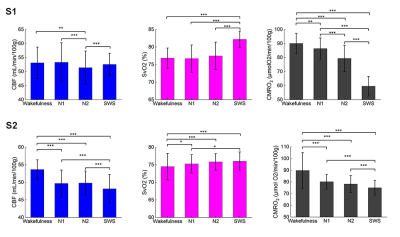 |
15 |
Alterations in cerebral metabolism from wakefulness to non-REM
sleep
Jing Xu1,
Michael C Langham1,
Hengyi Rao2,
Marianne Nabbout1,
Alessandra S Caporale1,3,4,
Alexander M Barclay1,
John A Detre2,
and Felix W Wehrli1
1Department of Radiology, University of Pennsylvania, Philadelphia, PA, United States, 2Department of Neurology, University of Pennsylvania, Philadelphia, PA, United States, 3Department of Neurosciences, ‘G. d’Annunzio University’ of Chieti-Pescara, Chieti, Italy, 4Institute for Advanced Biomedical Technologies (ITAB), ‘G. d’Annunzio University’ of Chieti-Pescara, Chieti, Italy Keywords: Data Analysis, Metabolism Sleep is fundamental to human health and function. Cerebral metabolism and blood supply are key physiological parameters of brain function, but the manner in which they change during different sleep stages is still largely unknown. In this study, we collected wakefulness and sleep data with concurrent EEG-MRI. We measured CBF, SvO2 and CMRO2 with radial OxFlow MRI. Our data show that CMRO2 is lower during non-REM sleep than during wakefulness and declines progressively as sleep stages become deeper. CBF decreases during non-REM sleep compared with wakefulness, while SvO2 gradually increases from wakefulness to slow wave sleep. |
|
3949. |
16 |
Apparent diffusion coefficients of 31P metabolites in the human
calf muscle at 7T
Zhiwei Huang1,
Giulio Gambarota2,
Ying Xiao1,
Daniel Wenz1,
and Lijing Xin1
1Animal imaging and technology core (AIT), Center for Biomedical Imaging (CIBM), Ecole Polytechnique Fédérale de Lausanne, Ecublens, Switzerland, 2Faculty of Pharmacy, University of Rennes, Rennes, France Keywords: Data Acquisition, Spectroscopy, Diffusion 31P diffusion magnetic resonance spectroscopy could assess the diffusion properties of high energy metabolites. In this study, a diffusion weighted (DW) STEAM sequence was implemented, and spectra were acquired in the human calf muscle of six healthy volunteers. Frequency and phase alignments were applied prior to spectral averaging. The ADC of phosphocreatine (PCr), adenosine triphosphate (ATP), inorganic phosphate (Pi) and glycerol phosphorylcholine (GPC) were (0.24±0.02, 0.15±0.04, 0.43±0.14, 0.40±0.09)×10-3 mm2/s. To the best of our knowledge, this is the first study reporting the ADCs of ATP, Pi, and GPC, and the second study reporting the ADC of PCr in human. |
|
3950.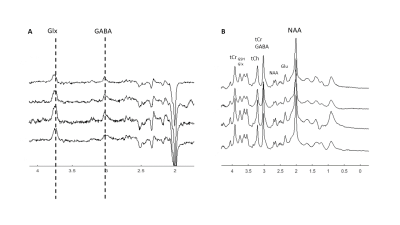 |
17 |
Long-term balance training enhances sensorimotor GABA levels in
older adults: A 7 T longitudinal magnetic resonance spectroscopy
study
Xinyu Liu1,2,3,
Selin Scherrer4,
Sven Egger4,
Song-I Lim1,3,
Benedikt Lauber4,
Wolfgang Taube4,
and Lijing Xin1,3
1Animal Imaging and Technology, Ecole Polytechnique Fédérale de Lausanne, Lausanne, Switzerland, 2Laboratory for functional and metabolic imaging (LIFMET), Ecole Polytechnique Fédérale de Lausanne, Lausanne, Switzerland, 3Center for Biomedical Imaging (CIBM), Lausanne, Switzerland, 4Department of Neurosciences and Movement Science, University of Fribourg, Fribourg, Switzerland Keywords: Data Acquisition, Spectroscopy, Data analysis, motor training, GABA, 7 Tesla This study aims to examine the modulatory effect of long-term balance training on sensorimotor cortex GABA level in an older population. In-vivo GABA levels were accessed using in-vivo MR spectroscopy (MRS) at 7T. GABA level in sensorimotor cortex was measured in sixteen healthy older adults using MEGA-sSPECIAL sequence, and short echo time semi-sSPECIAL sequence was used for metabolite profiling, before and after a three-months period of balance training. Using edited MEGA-sSPECIAL we detected a significant increase in sensorimotor GABA level after training, indicating potentially enhanced motor inhibition by coordinative balance learning. |
|
3951.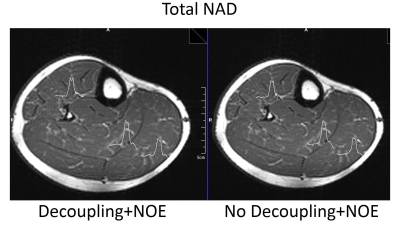 |
18 |
Two Dimensional MRSI of Human Calf Muscle at 3T: Decoupling and
NOE effects on PDE and total NAD
Rajakumar Nagarajan1,
Jane A Kent2,
and Gwenael Layec2
1Human Magnetic Resonance Center, Institute for Applied Life Sciences, University of Massachusetts, Amherst MA, Amherst, MA, United States, 2Kinesiology, University of Massachusetts, Amherst MA, Amherst, MA, United States Keywords: Data Acquisition, Spectroscopy Using two-dimensional 31-phosphorus spectroscopic imaging (2D-MRSI) in human skeletal muscle, we have demonstrated that proton decoupling and nuclear Overhauser effect sequences improve the coefficient of variation and enhance the resolution of key metabolites in vivo. |
|
3952.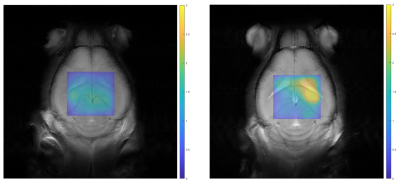 |
19 |
GABA spectroscopic imaging at 9.4T to localize the epileptogenic
zone in an animal model of focal epilepsy
Alicia Plaindoux1,
Yann Le Fur2,
Jia Guo3,
Clothilde Courivaud1,
Julien Valette4,
Vasile Stupar1,5,
and Florence Fauvelle1,5
1Grenoble Institute Neurosciences, INSERM, U1216, University Grenoble Alpes, Grenoble, France, 2CRMBM, Aix-Marseille University, Marseille, France, 3Departement of Psychiatry, Columbia University, New York, NY, United States, 4Université Paris-Saclay, CEA, CNRS, MIRCen, Laboratoire des Maladies Neurodégénératives, Fontenay-aux-Roses, France, 5IRMaGe, INSERM, US17, CNRS, UMS 3552, CHU Grenoble Alpes, University Grenoble Alpes, Grenoble, France Keywords: Data Acquisition, Spectroscopy, MEGA-LASER, CSI, edition A surgical resection of the epileptogenic zone (EZ) can be proposed to drug-resistant epileptic patients, mainly suffering from focal epilepsy, in order to free them from their seizures. However, the mean efficiency of surgery is around 50 to 80%, indicating a possible miss-delimitation of the EZ. In recent studies, GABA was found to be a specific biomarker of the EZ in a mouse model of mesio-temporal lobe epilepsy (MTLE). Therefore, in this project, we propose a GABA-edited spectroscopic imaging method to improve the spatial localization of the EZ in this mouse model. |
|
3953.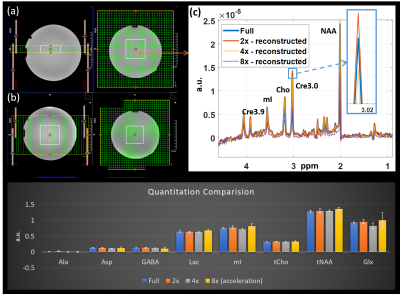 |
20 |
Accelerated Rosette Spectroscopic Imaging with semi-LASER
Localization
Ajin Joy1,
Uzay Emir2,3,
Paul M. Macey4,
and M. Albert Thomas1
1Radiological Sciences, University of California, Los Angeles, Los Angeles, CA, United States, 2School of Health Sciences, Purdue University, West Lafayette, IN, United States, 3Weldon School of Biomedical Engineering, Purdue University, West Lafayette, IN, United States, 4School of Nursing and Brain Research Institute, University of California, Los Angeles, Los Angeles, CA, United States Keywords: Data Processing, Brain Limiting the total data acquisition time to a clinically feasible runtime has been a major challenge in MR spectroscopic imaging. Recently rosette based non-cartesian encoding of k-space has been used for spectroscopic imaging due to their fast encoding speed and lower gradient/slew rate requirements. While rosette spectroscopic imaging has been attempted for 2D and 3D spectroscopic imaging, feasibility of undersampling the petals in rosette is not shown. In this study, we implemented a rosette 2D and 3D spectroscopic imaging sequence and shown the feasibility of acceleration factors up to 8x using compressed sensing reconstruction. |
|
The International Society for Magnetic Resonance in Medicine is accredited by the Accreditation Council for Continuing Medical Education to provide continuing medical education for physicians.